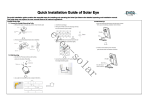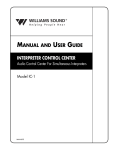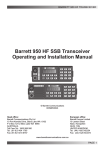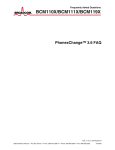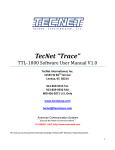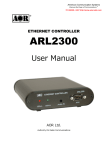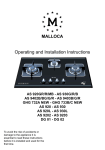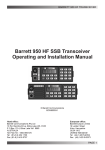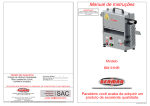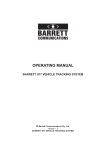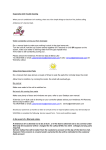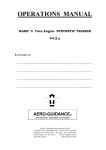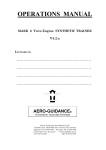Download barrett 911 automatic antenna tuner installation manual
Transcript
BARRETT 911 AUTOMATIC ANTENNA TUNER INSTALLATION MANUAL American Communication Systems Discover the Power of Communications ™ TO ORDER – VISIT http://www.ameradio.com Head Office: Barrett Communications Pty Ltd, 10 Port Kembla Drive, Bibra Lake WA 6163 P O Box 1214, Bibra Lake WA 6163 AUSTRALIA Toll Free Tel: 1800 999 580 Tel: (61-8) 9434 1700 Fax: (61-8) 9418 6757 [email protected] BCM91101/1 Barrett 911 AUTOMATIC ANTENNA TUNER SPECIFICATIONS Frequency Range Maximum power input Input impedance range DC power requirement Input current (average) Random tune time Recurrent tune time Minimum antenna length Operating temperature Dimensions Weight 1.6 to 30.0 MHz 150 Watts (PEP) 50 ohms nominal 13.8V DC 0.9 Amps Typically less than 2 seconds Typically less than 10 milliseconds 2.6 metres 3.3 to 30.0 MHz 7.0 metres 1.6 to 30.0 MHz -10C to +60C 350 x 284 x 70 mm 3.4 Kg GENERAL The Barrett 911 Automatic Antenna Tuner is designed for use in land base station and maritime HF services. Primarily designed for operation with end-fed unbalanced antennas such as whips and long wires, the tuner is built in a waterproof impact resistant, moulded ABS plastic enclosure. ANTENNA SELECTION The 911 Automatic Antenna Tuner will operate into almost any end-fed antenna with a length exceeding 2.5 metres, providing an effective ground (earth) is used. The antenna efficiency will be proportional to the length of the antenna and will be maximum when the length of the antenna approaches 1/4 wavelength. It is advisable to limit the wire antenna to 1/4 or 3/4 wavelength at the highest frequency to be used. 3. The water pipe enters soil with good conductivity. MARINE INSTALLATIONS 4. A low resistance joint is made with the water pipe. Antenna Frequently the ground conductivity will not be sufficient to provide a satisfactory ground for the Barrett 911 Tuner. This will almost certainly be the case in well drained sandy soils or on rock. In these cases a counterpoise must be used as a ground system. This will also be the case in rooftop installations where no existing ground plate (such as metal roofing exists). A counterpoise can consist of radial wires or a mesh made of materials such as chicken wire. If radial wires are used the counterpoise should consist of at least 8 to 10 radial wires. When radials or mesh are used at ground level it is recommended that they be buried a few centimetres below the surface. On sailing vessels the antenna can either be an insulated backstay or a whip antenna mounted vertically, usually on the stern. Best performance will be achieved by using an insulated backstay as the radiating length will be longer than that available when using a whip. The top insulator on the backstay should be approximately 300mm from the mast and the bottom insulator should be at eye level above the deck. The distance between insulators should be greater than 10 metres and less than 35 metres. A whip antenna is generally used on small to medium sized power vessels. There are different length whips to suit the vessel length. Transceiver and Tuner Mounting ELECTRICAL CHECKOUT After mechanical installation is complete select the highest frequency to be used on the transceiver. A directional wattmeter such as a Bird Model 43 should be inserted in the coaxial transmission line between the transceiver and the tuner. The tune mode on the transceiver is then energised (Refer to the transceiver user manual). Upon application of RF energy, the tuner should start to tune, indicated by the 'clattering' of the tuner relays. After a few seconds the relay noise will cease the transceiver should indicate a successful tune and the wattmeter reflected power should indicate a low value consistent with a VSWR of better than 2:1. If the cover of the tuner is removed the PCB mounted 'TUNED' LED should be illuminated. Now select the lowest desired frequency on the transceiver and repeat the above procedure. The result should be the same, except that the tune cycle may take somewhat longer. If the above procedure does not give the results as indicated check that the antenna length and connections are correct and re-check all ground (earth) connections. Note:- When received, the Barrett 911 Automatic Antenna Tuner memory system will usually not have any pre-stored tuning information appropriate to your installation. To allow the 911 to 'learn' its tuning information simply proceed from one channel to the next allowing the normal tune cycle to take place. Each successful tune is 'memorised' so that when that channel is reselected the tuner will almost instantaneously retune to that frequency. Select a suitable position in the vessel to mount the transceiver. It should be a position that is out of the weather and easily accessible to the operator, whilst as close as practical to the 13.8V DC power source. Mount the transceiver to a solid fixing point using the mounting cradle. Make sure there is sufficient space at the rear of the transceiver to connect the power and antenna cables. The antenna tuner should be mounted as close to the antenna feed point as possible. In metal vessels the length of the feeder from the antenna tuner to the feed-through insulator, inside the vessel, should be kept less than 1 metre. The antenna feed cable should be a suitable high voltage cable. Care should be taken to avoid sharp points when terminating the cable to prevent corona discharges. The interconnect cable supplied with the antenna tuner should be routed away from other cables back to the transceiver and connected as indicated in the diagram overleaf. Ground (Earth) System The ground (earth) system is a key part of the overall antenna system and consequently the system operation. An inadequate ground system is the primary cause of poor performance and tuning problems. There is little point in installing the antenna unless a good ground system can be provided. Metal hulled vessels provide an almost perfect ground. The tuner ground terminal should be connected directly to the hull using the shortest possible ground strap. The point of connection to the hull should be prepared so that it is free of paint and rust to ensure a good contact area with minimum electrical resistance. Wooden or fibreglass vessels present more of a problem to ground. Ideally the vessel should be fitted with an external copper ground sheet, connected to the interior of the vessel by suitable stud or an earth plate ("E" plate Barrett P/N BCA51700) If the vessel is yet to be constructed, then in the case of fibreglass vessels a thin copper sheet with an area of not less than 4 square metres should be moulded into the hull during lamination. A suitable heavy strap should be connected to the sheet and left free for earth connection. Should neither of these methods be available it will be necessary to bond as many large metallic objects, such as the engine and propeller shaft, together to form a ground. BASE STATION INSTALLATIONS Which ever method is used the ground run from the ground system to the antenna tuner should be as short as possible and use copper strap at least 50mm wide.(wider if available). Consideration must always be given to the problem of electrolysis. Severe structural damage may occur if electrolysis is present. Various antenna configurations, such as vertical whips, long-wires and loops, can be used for base station installations, using the Barrett 911 Automatic Antenna Tuner. Antenna In general however the following points should be considered:Corrosion 1. The antenna should be mounted as far away as possible from buildings, trees, vegetation and sources of electrical interference. If metallic masts or supports are used, arrange insulators to ensure the antenna is spaced at least 2 metres from the mast. 2. Remember the radiating part of the antenna starts at the tuner. The location of the bottom portion of the antenna is very important. 3. Horizontal wire antennas have maximum radiation broadside to the antenna when the frequency is less than 1/4 wavelength. Radiation is at a minimum at the end points of the antenna. 4. Inverted "V" installation of horizontal antennas minimises the directivity and is recommended for omni-directional coverage. 5. High voltages are present on the antenna system. The antenna tuner and antenna should be located or protected so that there is no possibility of accidental contact. All connections in marine situations are subject to corrosion and oxidation. To minimise this all joints should be cleaned and have silicon grease applied before assembly. Under severe conditions joints should be protected with self vulcanising rubber tape. Barrett 550/950 or 530/930 Connection Detail REMOTE CONTROL HEAD SUPPLIED STANDARD WITH 930/950 REMOTE CONTROL (TRUNK MOUNT) TRANSCEIVER OR AS AN OPTION IF DUAL CONTROL IS REQUIRED WITH A 930/950 LOCAL CONTROL TRANSCEIVER ANTENNA FEEDTHRU INSULATOR P/N BCA91701 STANDARD INTERFACE SUPPLIED WITH 911 ANTENNA TUNER 6 METRE REMOTE CONTROL CABLE WITH 930R/950 911 AUTOMATIC ANTENNA TUNER OPTIONAL ACCESSORY INTERFACE P/N BCA 90016 6 METRE CABLE & CONNECTORS SUPPLIED WITH 911 ANTENNA TUNER CABLE & CONNECTORS SUPPLIED WITH 911 ANTENNA TUNER OPTIONAL 10 or 6 METRE EXTENTION CABLE WITH CONNECTORS +13.8V P/N BCA 90032/40 GND BLACK EXTENSION SPEAKER AND MICROPHONE SUPPLIED STANDARD WITH REMOTE HEAD Transceiver and Tuner Mounting The transceiver should be mounted in a suitable position allowing easy operator access. The antenna tuner should be mounted, preferably out of the weather, and as close to the ground (earth) point as possible. The interconnect cable supplied with the antenna tuner should be routed, away from other cables, back to the transceiver and connected as indicated in the diagram. Ground (Earth) System 6 METRE POWER CABLE SUPPLIED WITH TRANSCEIVER HEAVY DUTY FUSE & HOLDER P/N BCA90018 The ground (earth) system is a key part of the overall antenna system and consequently the system operation. An inadequate ground system is the primary cause of poor performance and tuning problems. There is little point in installing the antenna unless a good ground system can be provided. In areas of good ground conductivity (ie. ground always damp), an effective ground can be made through a grounding rod. This should be approx. 3 metres in length and should be installed as close to the tuner as possible. Several rods bonded together will improve the ground contact. In some cases metal water pipes may be used as a ground providing:1. The water pipe is close to the tuner and the water pipe enters the ground close to the tuner. 2. There are no joints or couplings in the pipe that will increase the resistance path to ground.






